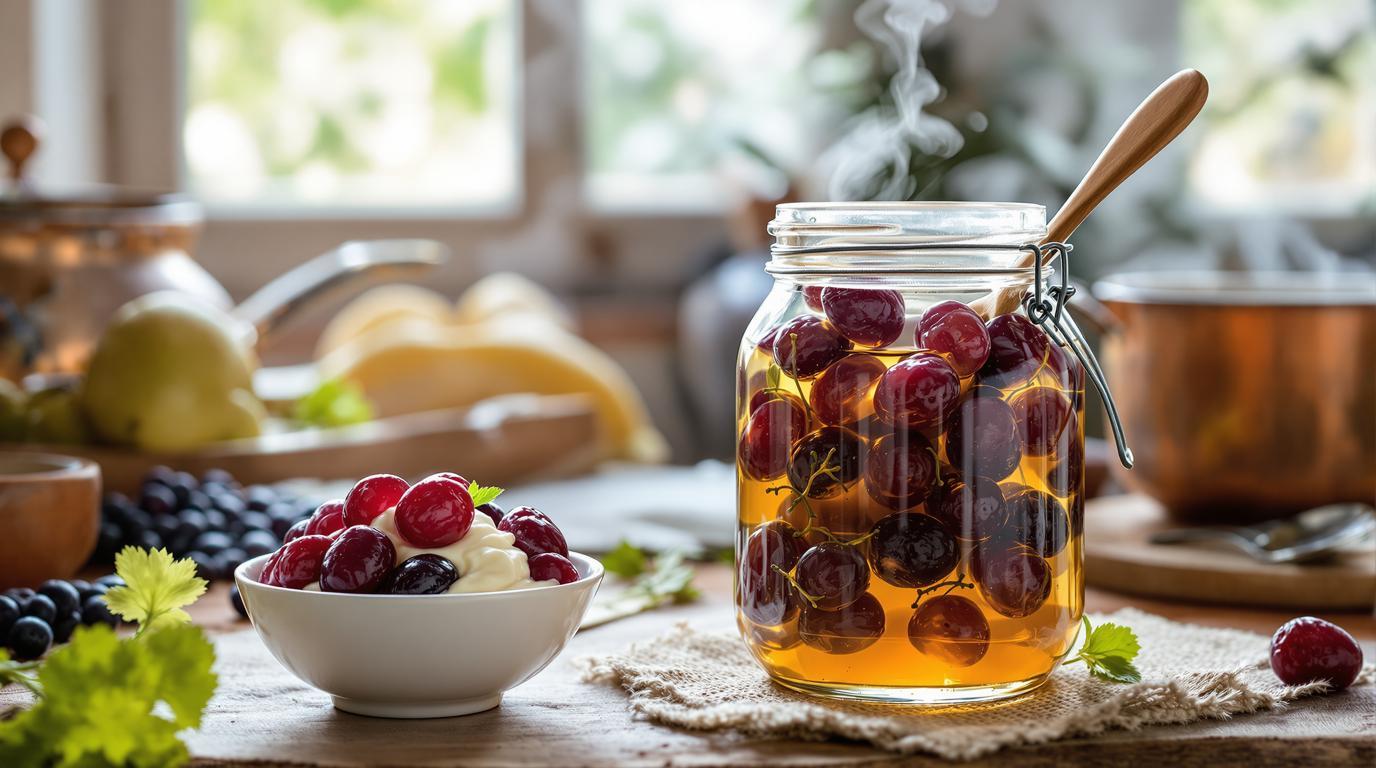There’s something almost magical about preserving the essence of summer fruit for those cold winter months. That’s why I’ve always had a special place in my heart for Greek spoon sweets, especially when made with gorgeous wine grapes. While traveling through northern Greece years ago, I stumbled upon the fascinating Xinomavro grape – a variety the locals primarily use for their robust red wines but occasionally preserve using age-old methods passed down through generations. Today, I’m sharing my adaptation of this traditional preserve that captures the grape’s unique character.
The Story Behind Xinomavro Grape Spoon Sweet
Xinomavro (pronounced ksee-NO-mav-ro) literally means “acid black” in Greek, a fitting name for this tannic, complex grape that forms the backbone of some of Greece’s most celebrated wines. While wandering through the vineyards of Naoussa, I learned that elderly yiayias (grandmothers) would occasionally set aside small batches of these wine grapes to create precious jars of spoon sweet – a traditional Greek preserve served to guests as a gesture of hospitality. While muscat varieties are more commonly used, the occasional Xinomavro version offers a deeper, more complex flavor profile that’s absolutely worth trying.
Essential Ingredients
For this special preserve, you’ll need:
- 1½ pounds (680g) fresh Xinomavro grapes (or substitute with black seedless grapes)
- 1 cup (200g) granulated sugar
- 1½ tablespoons fresh lemon juice
- 1 cup (240ml) water
- 1 cinnamon stick (optional)
Chef’s Note: Xinomavro grapes have thicker skins and can be quite tannic, which makes them perfect for wine but challenging for eating fresh. If you can’t source Xinomavro, black seedless grapes make an excellent substitute while maintaining the visual appeal. For authentic flavor, consider adding a splash of Xinomavro wine to the cooking liquid.
Step-by-Step Instructions
1. Prepare the grapes: Gently wash the grapes and remove them from their stems. If using Xinomavro, you may want to carefully halve them and remove seeds (though traditionally, many Greek cooks leave them whole).
2. Combine ingredients: In a wide, heavy-bottomed pot, combine the grapes, sugar, lemon juice, and water. The wide pot is crucial – it allows moisture to evaporate more quickly, resulting in a better-textured syrup.
3. Initial cooking: Bring the mixture to a gentle simmer over medium-low heat (around 160°F/71°C). As the mixture heats, you’ll notice the grapes beginning to release their pigment and juices.
4. Low and slow: Reduce heat to maintain a gentle simmer for 30-40 minutes. Stir occasionally, but gently – aggressive stirring will break the grapes. You want them softened but still intact.
5. Test the syrup: The preserve is ready when the syrup coats the back of a spoon. For a more precise test, place a small drop on a cold plate – it should hold its shape and not run excessively.
6. Rest and settle: Once cooked, allow the mixture to rest at room temperature for 24 hours. This crucial step allows residual moisture to escape and flavors to develop fully.
Chef’s Secret Techniques
The key to perfect spoon sweets lies in the gentle cooking process. Unlike jam-making where we aim for a rapid boil, spoon sweets demand patience and restraint. I learned from a Greek grandmother in Naoussa that the goal is to gradually coax the fruit’s essence into the syrup while maintaining the grape’s structural integrity.
To prevent crystallization (a common issue), add a teaspoon of honey or substitute 1/4 cup of the sugar with white corn syrup. Also, avoid stirring once the sugar has dissolved – instead, gently shake the pot to move the grapes around.
Serving & Presentation Tips
Traditionally, this preserve is served on small plates with tiny spoons (hence the name “spoon sweet”), alongside a glass of cold water. For a modern twist that honors the grape’s heritage, I like to serve it alongside creamy gelato or spooned over Greek yogurt with toasted walnuts.
For entertaining, try creating a Mediterranean dessert board featuring this spoon sweet alongside Italian cheese and thin slices of honey cake. The sweet-tangy preserve balances beautifully with savory elements, much like a vibrant poke bowl brings together contrasting flavors.
Remember, making preserves like this connects us to centuries of culinary tradition. There’s something profoundly satisfying about transforming seasonal fruit into jars of jewel-toned sweetness that can brighten even the darkest winter day. The Xinomavro grape – whether in wine or preserve form – truly embodies the soul of Greek cuisine: humble ingredients transformed through time-honored techniques into something extraordinary. I hope you’ll give this special preserve a try!
